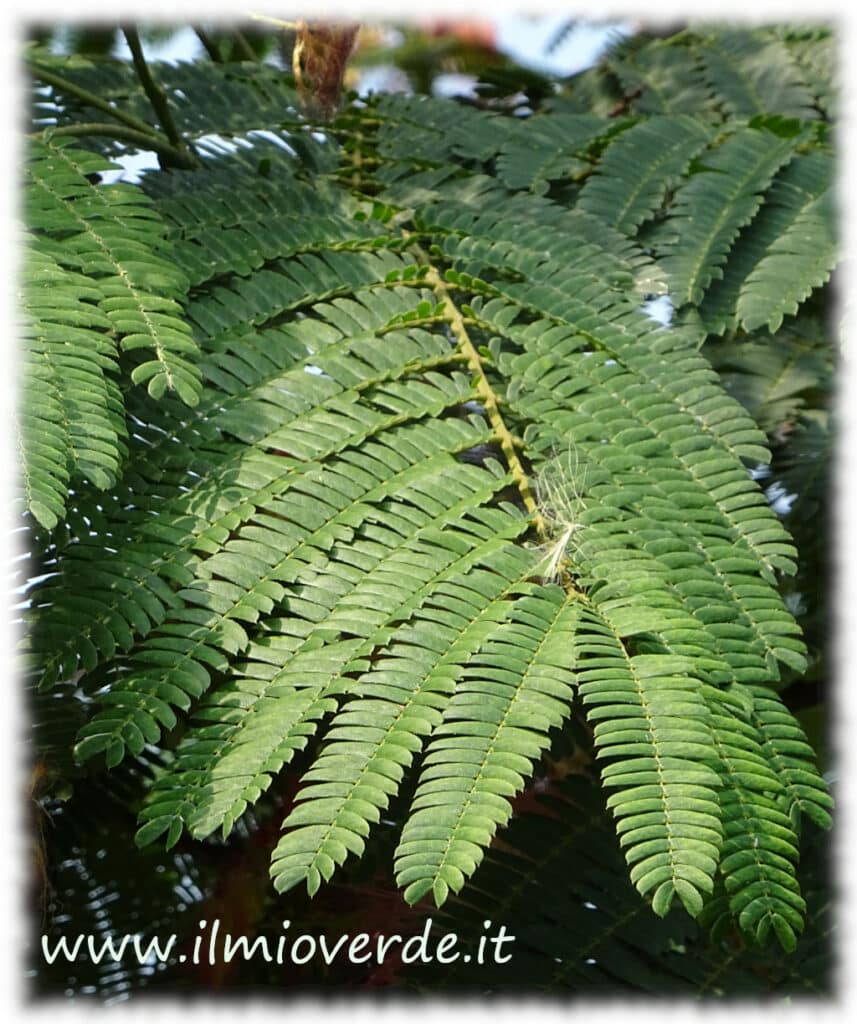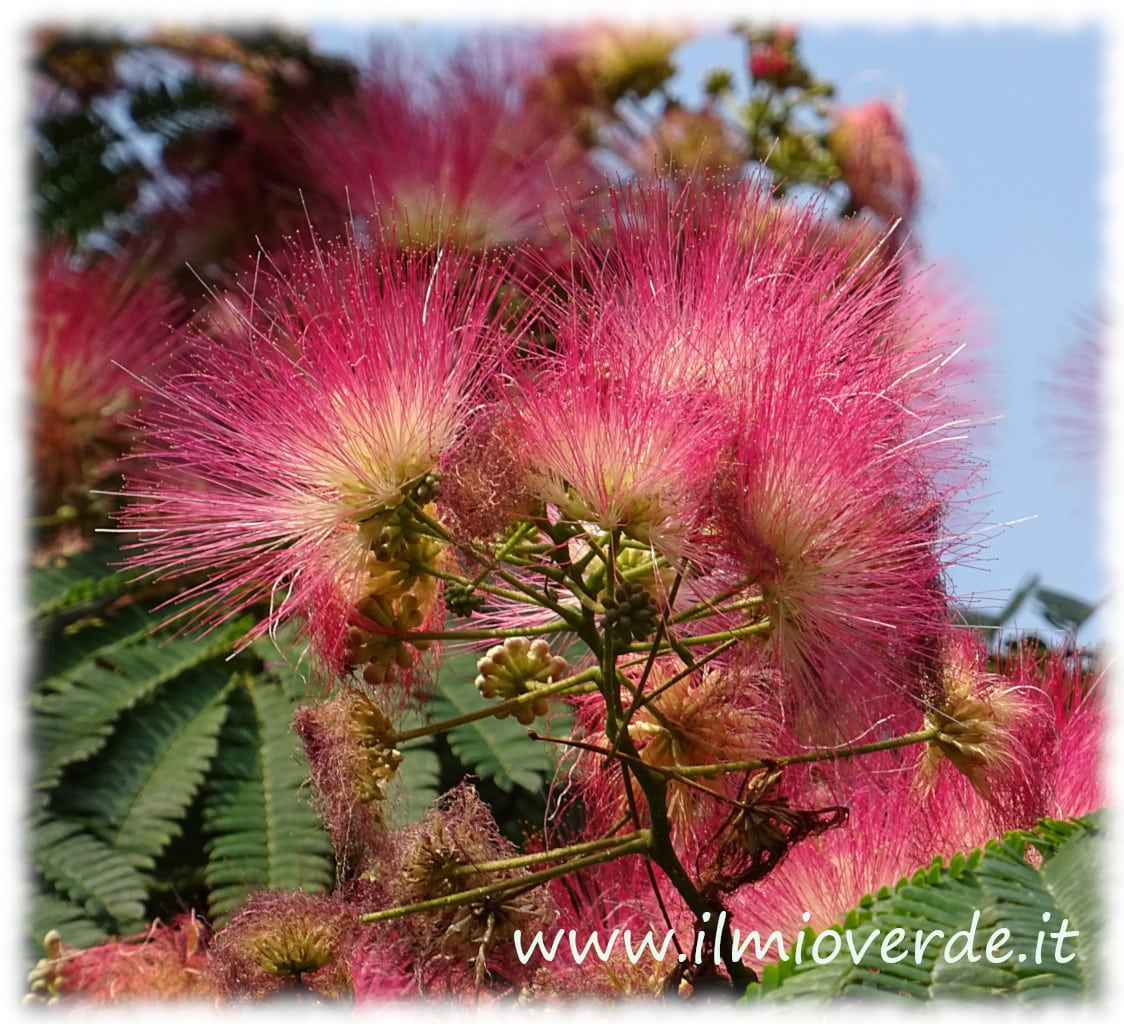Albizia julibrissin
Albizia julibrissin, commonly known as the Persian Acacia or Albizia rosea, is an ornamental plant that captivates everyone with its elegance and spectacular flowering. Native to Western Asia and Iran, this species from the Fabaceae family is appreciated for its striking flowers and its ability to adapt to various climatic conditions. Let’s take a closer look at its features and how to care for this natural beauty.
Plant Characteristics
- Height: It can reach 10-12 metres when planted in the ground. In a pot, it remains more compact.
- Shape: A tree or shrub with a pyramidal or globe-like shape, finely divided leaves, and elegant foliage.
- Flowering: The flowers are spectacular, intense pink, and pompom-shaped, blooming during the summer.
- Fruits: The fruits are slender, brown legumes that mature in autumn.
- Leaf: Characterised by an elegant finish and a delicately divided structure.
Benefits for Wildlife
- Attracts Pollinators: Bees and butterflies are attracted to the plant thanks to its nectar-rich blooms.
- Soil Improvement: Like many legumes, Albizia enriches the soil with nitrogen, improving soil quality.
- Ornamental Use: Ideal as a specimen plant or in groups in gardens, it is also perfect for forming a tall hedge or a shade tree.
- Medicinal Properties: In some traditions, Albizia bark is used in natural medicine for its relaxing and sedative properties.
Ideal Growing Conditions
Albizia julibrissin is a hardy plant that thrives in warm and temperate climates. Its heat tolerance and drought resistance make it an ideal plant for Mediterranean gardens and areas with hot, dry summers.
- Climate: Prefers warm climates but can withstand temperatures as low as -10°C, although in areas with particularly harsh winters, it may suffer.
- Exposure: It loves full sun, which enhances its flowering and vigorous growth.
- Soil: It can grow in well-drained soils, preferring light, sandy, or slightly acidic soils.
- Watering: Although it tolerates short periods of drought, it is advisable to water regularly during the summer, especially when grown in containers.
Maintenance and Care of Albizia julibrissin
Albizia is a low-maintenance plant that requires minimal intervention.
- Fertilising: It can benefit from a balanced fertiliser during the growing season (spring-summer), but it is not particularly nutrient-hungry.
- Pruning: Pruning is essential to maintain an orderly shape and stimulate healthy growth. It is recommended to remove dead or diseased branches in early spring.
- Winter Protection: In areas with harsh winters, especially for young plants, it is best to protect the base of the plant with mulch or breathable fabrics to prevent frost damage.
Benefits and Uses
Albizia julibrissin is highly valued not only for its ornamental appearance but also for its many ecological benefits.
- Benefits for Wildlife: It attracts pollinators such as bees and butterflies with its nectar-rich blooms.
- Soil Improvement: Like many legumes, Albizia enriches the soil with nitrogen, improving soil quality.
- Ornamental Use: Perfect as a specimen plant or in groups in gardens, it is also ideal for forming a tall hedge or a shade tree.
- Medicinal Properties: In some traditions, Albizia bark is used in natural medicine for its relaxing and sedative properties.
Diseases and Pests
Albizia julibrissin is generally resistant to many diseases, but it may be susceptible to some issues such as:
- Aphids: These small insects can suck sap from the leaves and cause damage. They can be controlled with insecticidal soap treatments.
- Grey Mold: In humid environments, the plant may suffer from grey mold, which can be prevented with good air circulation and humidity control.
Albizia julibrissin is an extraordinary plant for the garden, thanks to its beauty and resilience. Easy to grow and care for, it is a perfect addition for anyone who desires a touch of exoticism and colour. If kept in ideal conditions, this plant will provide a spectacular summer bloom and a majestic presence in the garden for years to come.
Link

